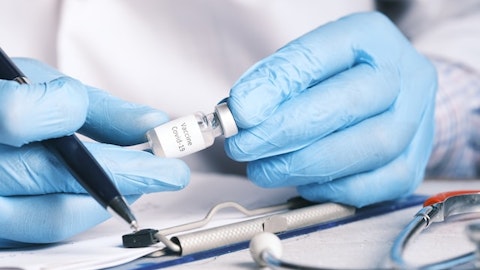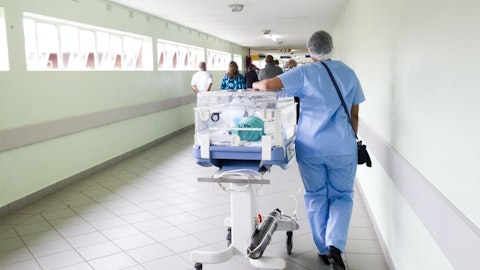AdaptHealth Corp. (NASDAQ:AHCO) Q3 2023 Earnings Call Transcript November 7, 2023
AdaptHealth Corp. beats earnings expectations. Reported EPS is $0.42, expectations were $0.19.
Operator: Good day, everyone, and welcome to today’s AdaptHealth Third Quarter 2023 Earnings Release Call. At this time, all participants are in a listen-only mode. Later you will have an opportunity to ask questions during the question-and-answer session. [Operator Instructions]. It is now my pleasure to turn today’s call over to Richard Barasch, Chairman and Interim CEO. Please go ahead.
Richard Barasch: Good morning, everyone. Thank you for joining us today to discuss AdaptHealth’s third quarter performance. Before we begin, I’d like to remind everyone that statements included in this conference call and in the press release issued today may constitute forward-looking statements within the meaning of the Private Securities Litigation Reform Act. These statements include, but are not limited to comments regarding financial results for 2023 and beyond. Actual results could differ materially from those projected in forward-looking statements because of a number of risk factors and uncertainties, which are discussed at length in the company’s annual and quarterly SEC filings. AdaptHealth Corp. should have no obligation to update the information provided on this call to reflect such subsequent events.
Additionally, on this call, the company will reference certain financial measures, such as EBITDA, adjusted EBITDA, and free cash flow, all of which are non-GAAP financial measures. This morning’s call is being recorded, and a replay of the call will be available later today. We are pleased with the results of the third quarter. Powered by our Sleep business, we generated 6.3% growth over last year, leading to record revenues for the quarter. Equally important, we generated cash flow from operations of $98.8 million and free cash flow of $21.7 million. Adjusted EBITDA fell short of our expectations largely as a result of unplanned delays in the implementation of the Humana contract. Jason and I will get into more detail on why this happened, but these results do not reduce our optimism that this will be a profitable contract for AdaptHealth nor does it diminish our enthusiasm for more enterprise sales of this time.
Other than this contract, we would have met our expectations for revenue, adjusted EBITDA, margins and cash flow in the quarter. Our sleep product line continues to outperform, resulting a 17% increase over last year. Our new PAP starts were consistent with our expectations and our PAP resupply business generated record order volumes. An important metric is that our resupply census has grown 12% over the past year and now totals over 1.5 million patients. Among the reasons we continue to grow is that we are focused on electronic ordering, which reduces friction and enhances the patient experience. The relationship that we’ve established with these patients is a critical aspect of our strategy to become more than just a provider of devices and supplies.
Building on the strong trends in the first half of the year, we grew our respiratory net revenue by over 8% year-on-year. This growth was driven by increased patient census, coupled with stabilization in the length of time patients remain on oxygen and vents. Diabetes continues to be a work in progress, as discussed last quarter. While the results in the third quarter were a bit softer than we had planned, we are encouraged by the progress we are making to improve this vital product line. To resume growth, we are focusing our sales efforts towards the growing government business, especially in areas where diabetes is prevalent. The government market for CGMs and pumps is large and growing, and we are continuing to shift our strategy to specifically focus on the acquisition and retention of these patients.
Government sponsored payers are now 79% of our CGM census, up 200 basis points versus last quarter. We are rapidly recruiting dedicated diabetes representatives in the areas of high diabetes prevalence, leveraging the scale and capability of the entire AdaptHealth sales team. Our objective is to double the number of diabetes sales reps over the next several months. We’re also exploring strategies to participate profitably in the growing pharmacy sales channel. This will allow us to regain some of the share that we relinquished as more commercial payers move to the pharmacy channel. Finally, and quite promising is that we are beginning to execute a strategy to use the data generated from CGMs to create a better patient experience, while generating information that is important for their providers and payers.
This will enhance our value proposition to all of our constituents. Our experience in the early days of the Humana implementation has not diminished our optimism about the value that this contract will provide to all parties to the transaction. We’ve established a very strong relationship with Humana, and we’ve been working to make the transition process as seamless as possible for Humana members who will ultimately benefit from better service for their HME needs. Unfortunately, however, we underestimated the size and complexity of the patient transition process. Onboarding members is taking longer than we had anticipated, resulted in a reduction to our expected CAP revenues from Humana. Nevertheless, we remain confident that this agreement will achieve positive results for AdaptHealth.
Since AdaptHealth went public in 2019, we’ve increased revenue and adjusted EBITDA each year and have recently improved our cash flow and strengthened our balance sheet. However, we must take responsibility for issues, some self-inflicted, that have caused a reduction in investor confidence, including setbacks around the CEO of search. The top priority for our Board is to fill the CEO job with the best candidate as soon as possible. We are currently talking to highly capable candidates with the goal of having the post filled by year-end. In the meantime, we’re not slowing down, and I’d like to describe the key initiatives and goals that our Board and management are aligned on. Further increases in cash flow from operations and free cash flow is a high priority.
The company continues to focus on better collections, better inventory management and more efficient capital spending, all of which have contributed to our improved cash flow results. We recently used some of our free cash to buy back stock, but we were also addressing our balance sheet. During 2023, we paid down our revolver and reduced our leverage from 3.66x to 3.51x. We are fortunate to have a comfortable debt structure in terms of rates and maturities, but we intend to de-lever further with the goal of reducing our leverage to under 3x by the end of next year. As to the business itself, our short-term priorities are to solidify our diabetes line and resume a market rate of growth, expedite the transaction of the Humana business and expand our enterprise sales effort.
Continue to reduce the cost of operations through automation and better processes and implement our strategy to become even more relevant in the health care ecosystem. Finally, I’d like to comment on the affected GLP-1s in our sleep and diabetes product lines. Most important, we are seeing no current impact on our sleep product line. Our total sleep census, which is a combination of new starts and ongoing path resupply patients continues to grow at a pace that bodes well for continued revenue growth. Further, we have seen recent analysis that indicates that the affected GLP-1s on pack utilization may have been overstated in some earlier analysis and resulting market reaction. For example, one recent study indicated that only 3% of GLP-1 users with obstructive sleep apnea were able to stop using their PAP therapy.

Another recent piece highlighted the lack of adherence to GLP therapy over time. Others, ourselves included, think that the sleep TAM may actually grow as a result of more awareness and increased diagnosis of OSA as a result of the publicity around GLP-1s. Our working assumption though is that GLP-1 drugs will likely have a significant impact on obesity over time, which may cause some leakage to the current sleep TAM. How large and how soon are the subject of much speculation, but we will proactively respond to this potential pressure. If there is a net reduction in sleep TAM, we can overcome it by continuing to increase market share, decrease costs through automation and better processes and focus on patient retention. We’ve improved on each of these measures over the past few years and the GLP-1 conversation will accelerate our efforts in these basic areas.
There is more consensus that GLP-1 usage may accelerate growth — more GLP usage may accelerate growth in CGM usage. We believe that diabetes patients on GLP-1s are actively engaged in their health and will be inclined to monitor the A1C levels through CGS. We also believe that increased insurance coverage of CGM, especially in the government sector, is a strong tailwind. AdaptHealth is at the epicenter of efforts to improve the health of people with chronic conditions like obesity, diabetes, sleep apnea and COPD. We occupy a unique position, connecting providers, patients and payers. We currently have an ongoing relationship with over 1.5 million people with sleep apnea, roughly 170,000 diabetics and 300,000 people with chronic respiratory conditions.
We interact with these folks on a regular basis to help them with adherence to their therapies by supplying and resupplying needed equipment and coaching them as to better usage. Better adherence alone will improve outcomes and reduce downstream costs, where we are just now beginning to understand how we can compliantly use the data we are generating to do even more to improve the health of our patients, especially those with comorbidities. One early example is that we recently surveyed 10,000 people who set up on PAPs last month. Of these, 7% of those who responded and by the way, the response rate was over 40%. So we think this is a reasonably good sample. Of these, 7% are taking GLP-1s, which indicates that GLP-1 usage can coexist and will coexist with CPAP therapy.
Further, 20% of this group has diabetes, but only 15% of the diabetics are using CGMs to monitor their results. If we extrapolate these findings to our entire population, we will find many opportunities to identify and better service patients with comorbidities.
Jason Clemens: Thank you, Richard, and thanks to all for joining our call today. Let me begin by reviewing our third quarter results. We achieved record revenue of $804.0 million, an increase of 6.3% over the third quarter of 2022. Other than the Humana details that Richard described, this quarter met our expectations for top line growth and adjusted EBITDA, and cash flow exceeded our expectations. Our total sleep revenue of $315.4 million increased 17% against a year ago, driven by PAP equipment setups and increasing resupply. Our new PAP equipment starts were consistent with our expectations in the third quarter. Our PAP resupply business achieved record order volumes, our resupply census now totals over 1.5 million patients and our electronic ordering utilization broke company records.
Respiratory revenue of $151.1 million increased 8% over the third quarter of 2022. As we continue to revamp our diabetes product category, CGM census was up 4.3% year-over-year, resulting in flat CGM revenue. As expected, pump and pump supply revenue was down $9 million year-over-year as our tube-based pump volumes remain under pressure from tubeless pumps. We expect this pressure to continue into the fourth quarter. As Richard said, we are bolstering our sales force and focusing on growth in the government sector. Outsized growth in our sleep product category largely offset a shortfall in diabetes and a modest increase in operating expenses. So overall, except for the unexpected losses on the Humana start-up, our top line and bottom line results were in line with our expectations for the quarter.
The primary reason for the shortfall on the Humana contract was a delay in patient transitions and corresponding capitation deductions, resulting in a $10 million top and bottom line miss against our expectations. It will take longer than originally expected to transition to all patients, but we believe that we will indeed get substantially transitioned by early next year. As we continue transitioning patients, we expect sequential improvement in both our top and bottom lines. Our adjusted EBITDA was $161.2 million in the quarter, resulting in an adjusted EBITDA margin of 20.0%, down from 21.6% in the second quarter, primarily related to the patient transition backlog. Cash flow from operations in the third quarter was $98.8 million. CapEx was $77.1 million or 9.6% of revenue, resulting in free cash flow of $21.7 million.
For the first three quarters of 2023, we generated $76.6 million of free cash flow, which was more than 2.5x the first three quarters of 2022. We reiterate our full-year free cash flow goal of between 3% and 4% of revenue. For the third quarter of 2023, DSOs of 42.1 days were down over a day against 2022. And for the first three quarters of 2023, DSOs were 42.5 days, down from 44.8 days for the first three quarters of 2022. We continue to realize the benefits of our refining of revenue cycle process and investments we have made in our technology and workflow. Our net leverage ratio at the end of the quarter was 3.51x, down slightly from the second quarter. During the third quarter, we made principal payments of $10 million. And after the end of the quarter, we repurchased approximately 2.5 million shares in the open market for a total cost of $19.4 million.
As part of our third quarter results, we recorded a $511 million impairment to goodwill as we discussed in our earnings release this morning. This non-cash pretax charge was triggered by our stock price as of September 30th. Turning to guidance. We are revising our prior outlook as follows. We are narrowing our expected revenue range to $3.160 billion to $3.185 billion. We are updating our expected adjusted EBITDA range to $630 million to $650 million. And we are maintaining our expectations for total CapEx representing 10% to 12% of revenue, which should yield free cash flow of 3% to 4% of revenue. To close our comments today, we believe we’re well positioned heading into the final weeks of the year. We are turning around diabetes, we are focused on transitioning patients as part of our new relationship with Humana, and we are optimistic about our business overall.
With that, we will open the call for questions. Operator?
See also 13 Best Affordable Dividend Stocks To Buy and 12 Best Undervalued Dividend Stocks To Buy Now.
Q&A Session
Follow Adapthealth Corp.
Follow Adapthealth Corp.
Operator: Thank you. [Operator Instructions]. And we have our first question from Brian Tanquilut with Jefferies.
Unidentified Analyst: Good morning. You’ve got Taji on for Brian. Thank you for taking my question. So going back to the Humana contract, I really appreciate the color on the updated implementation timeline. But as we think about the profitability ramp, maybe you could provide some detail around your expectations around that and maybe outline the levers that will drive profitability at an accelerated rate?
Richard Barasch: Thank you for the question. We’re delayed. We’re talking about that. But we think once the transition occurs, we’re going to hedge them more had to a situation where the profitability of the contract is more consistent. We are ramping up our efforts to transition this quarter. It’s likely going to take us through the beginning, perhaps next quarter, but we feel very good that once that happens, we will resume the contract as we had originally planned it.
Jason Clemens: And Taji, this is Jason. I would say that at a unit economic or a patient level from this stage forward profitability as a percent will ramp very rapidly. The reason for that is, a cap deduction on, let’s say, an oxygen patient, the allowables, the fee schedules for that patient is around $120 a month. So for a full quarter, you got $360. You got thousands and thousands of patients on that oxygen allowable from competitors that still need to be transitioned. So as each and every one is transitioned, that entire amount is — it comes back as CAP [ph] revenue for us, and it drops 100% to our bottom line. So we do expect a good ramp from this stage forward as we continue staying focused on transitioning patients.
Unidentified Analyst: Appreciate the detail there. Just another follow-up. As I think about your guidance, looking at the midpoint, it implies a margin step-up in Q4. Just curious, the different puts and takes that are going to help you get that margin accretion in Q4?
Jason Clemens: Yes, sure, Taji. So firstly, we do historically enjoy a step-up in patient demand, particularly in our resupply categories. As insurance plan changeovers that occur in January as well as deductible resets, patients are hoping to get in front of that and stock up the resupply they need to carry them through the end of the year and into the New Year. So we are expecting, in our resupply lines, specifically sleep and diabetes, to be up over $20 million sequentially in Q4 from Q3. We expect that to flow at our typical purchase margin, call it about 40% of that, stepping down. So that’s the first sequential step-up in profitability in Q4. The second, Humana, as we said, kind of patient-by-patient. As we are transitioning patients, we do expect a material step-up in CAP payments and that bottom line that we spoke about as we’ve made key investments just over the last several weeks in additional resources and capability to ensure smooth patient transition.
Unidentified Analyst: Great. Appreciate the time.
Operator: And we have our next question from Matthew Blackman with Stifel.
Mathew Blackman: Good morning, everybody. Thanks for taking my questions. I’ve got two 2-parters. And maybe, Jason, if I could just start with you. Just curious to frame the guide down on revenues. How much of it was diabetes versus the Humana contract delay? And then the same impact on EBITDA? And the second part of the first question is, did the Humana contract disproportionately impact any specific franchise? And does it impact any specific franchises in 4Q as we think ahead? And then I’ll wait for the follow-up.
Jason Clemens: Yes, sure, Matt. So the first part of that question is the vast majority as we look towards Q4 is Humana-related. Diabetes, we did expect out of CGMs a little bit more in the third quarter, so we fell a bit short of that. So certainly, we’re rolling a touch of that into Q4. But again, the vast majority of this was Humana-related, just rolling the timing. And you’ve got the compounding effect going into the fourth quarter. And for the second — can you rephrase the second part of your question?
Mathew Blackman: The Humana — and when we think about the revenue…
Christopher Joyce: How the franchise…
Mathew Blackman: yes, does it disproportionately impact any specific franchise?
Christopher Joyce: Well, I don’t know that I’d say it impacts any franchise in terms of the guarding power and the go-forward. I will say that when you think about the second quarter revenue that we earned from the 33 states and the District of Columbia, where we won the Humana HMO contract, there was substantial revenue earned within the second quarter prior to the contract going into effect. And so much of that revenue was in the rental lines, specifically respiratory and then a little bit in PAP sleep and HME. And so starting July 1, 100% of that revenue is eliminated, right? It’s no longer a fee-for-service revenue that will go into Humana. And it converts to a patient per month revenue-wise. Of course, you’ve got the new patients coming on that also generate PMPM, but it does create a timing disconnect of your dropping out top and bottom line rental revenues.
And until you convert the competitor patients to bring that into the census, you’re left with this gap that we’re focused on today.
Mathew Blackman: Got it. I appreciate that. And then second question, part one. Can we zoom in a little bit more on the diabetes franchise? And I appreciate some of the color you gave us on the pump and CGM franchises. But just what are you seeing in terms of new patient starts and attrition? Is there anything that stands out? I think specifically on the attrition side relative to historical trends, just given all the noise we’re hearing with GLPs. And then the second part to that question is, what does have to happen for you to be able to push more aggressively into the pharmacy channel? Are you specifically horse-trading anything with payers? And to the extent that this does ultimately play out, is that patient worth a little bit less from a revenue and profitability standpoint through the pharmacy channel versus the DME? Just help us think through that opportunity and what sort of the moving parts are. Apologies for the long-winded question, but thanks.




